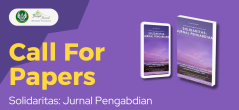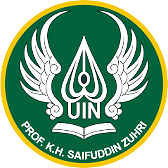Author Guideline
Introduction
Solidaritas: Jurnal Pengabdian is a scientific journal in the multidisciplinary field and published on the theme of community service results. Solidaritas: Jurnal Pengabdian opens opportunities for lecturers and researchers to publish community service activities in dealing with various problems, obstacles, potentials, and challenges in the community, which include Community Service to the Muslim community, Community Service in an Islamic perspective, Community Service to develop the Muslim community, Community Service to develop Islamic institutions (Islamic School, Islamic Boarding School, Mosques, Reciting Communities, Muslim Charity), and themes related to education and dedication to Islam.
Solidaritas: Jurnal Pengabdian is a peer-reviewed journal and open-access through the Open Journal System version 3.0 system. Solidaritas: Jurnal Pengabdian published by the Institute for Research and Community Service (LPPM) Universitas Islam Negeri Prof. K.H. Saifuddin Zuhri Purwokerto and published bianually in June and December. Manuscript templates, please download HERE.
Guidance to Write a Title, Name, Author's Address, and Abstract
- The manuscript's title is written at the top of the first page with the text position left aligned using the Cambria font with size 16 and in bold.
- The author's name is written without an academic degree using a Font letter Cambria size 11, followed by the author's affiliation and country name, while the Author and correspondence address is placed at the bottom of the page.
- If there is more than one author, the author's name must be written separately with a comma (,). The first name should not be abbreviated if the author's name consists of at least two words.
- Abstracts are written in Indonesian and English versions, minimum of 160 words and a maximum of 200 words.
- Abstracts are written using Font Letter Cambria size 9 with a space size of 1.
- Keywords should be written under the overall abstract for all words. Keywords are arranged alphabetically and semicolon-separated by a maximum of three to six words.
- The corresponding author, the second author, and so on must be written sequentially.
General Guidelines
The general guidelines for manuscript manuscripts are as follows:
- Manuscripts are a result of community service activity
- Manuscripts are original or are not being published in journals or other media.
- The script does not contain any element of plagiarism. The editorial board uses Turnitin software to perform similarity checks to avoid plagiarism. The maximum permitted similarity check limit is 20%.
- The process of submission and publication is complimentary at no additional cost. If the author wants a Quick Review process, a processing fee of RP.500,000 is charged.
- The manuscript is written following the guidelines of Solidaritas: Jurnal Pengabdian in MS.Word format using a manuscript template that can be downloaded on the Solidaritas: Jurnal Pengabdian website page.
- Submission of manuscripts and communication regarding manuscript revisions and final statements are carried out through the Online Submission System using the Open Journal System (OJS) version 3.0 on the Solidaritas: Jurnal Pengabdian portal: (http://ejournal.uinsaizu.ac.id/index.php/sjp)
- Manuscripts must complete aspects of a scientific manuscript, including: (1) the title of the manuscript, (2) the author's name (without academic degree), (3) the author's affiliation and address, (4) the author's email (5) abstracts and keywords, (6) the introduction, (7) the method of implementation, (8) the results and discussions, (9) conclusions, (10) acknowledgment (if any) and (11) bibliography.
- Avoid using subtitles in the body of the manuscript. If there are subtitles, please write in bold and capital letters at the beginning of the word. Use left text alignment without underscores.
- The manuscript is written in Bahasa Indonesia according to PUEBI language standards.
- The manuscript consists of 3000 to 4000 words, excluding images and tables. The manuscript must be written according to the journal template.
- The manuscript was written using the font Cambria 11pt, two stripes-spaces, separated into two columns (except the main title, author name, and abstract) with a space between the columns of 10 mm.
- Words from foreign languages or vernaculars are written in Italic format.
- If the data is presented in a table, the caption is placed at the top of the table. The inclusion of data in a table should be preceded or ended with a cross-reference.
- Images can be displayed in color images (full color) or grayscale. Captions must be numbered within one space. The title should be short (not on the image itself) and illustrative. Pay attention to the writing of the text; the illustrations should be clear and avoid using symbols and abbreviations. Letters should be easy to read, straightforward, and in proportional size. The number should briefly describe the central part of the text. For layout purposes, please provide the respective high-resolution numbers (≥300dpi).
Guideline to Manuscript Body Text
- Manuscript title: The title must be informative and written briefly and clearly, avoid multiple interpretations, and be relevant to the issues discussed. The initial word is written in capital letters with a left-aligned alignment style. The title of the manuscript does not contain uncommon abbreviations. The main idea should be written first and then followed by the explanation. The maximum manuscript title is written in twenty words, and the font is 16pt, with bold print and left-aligned text.
- The abstract should be written in 160-200 words and followed by three to six keywords. The abstract contains the introduction, implementation methods, results, and conclusions.
- The introduction reveals the background or problem, the urgency, rationalization of the community service activity, the purpose of the activities, and the problem-solving plan with short, concise, and clear sentences. The manuscript should be written using Cambria letter size 11.
- The implementation method describes the design of the community service activity, the location of the community service activity and participants, materials and tools, the method of implementing the community service activity, the method of data collection, data processing, and analysis.
- Results and Discussions contain the results of activities implementation, obstacles, and the impacts and struggles on the sustainability of activities. Results can be supplemented with tables, graphs, images, or charts.
- The conclusion section raises about the impact and benefits of the activity and recommendations for future community service activities.
- The acknowledgment is optional if needed.
Guide to Citations and References
- Write a direct quotation that exceeds four lines, put the quote on a new line and remove the quotation marks. In comparison, the quote that is less than four lines remains fused with the previous sentence. Citations/quotations using in note models, for example (Sukarta, 2018). If two writers then (Nunan & Choi, 2010). If more than three authors write the cited work, the citation uses et al., for example (Littlejohn et al., 2019). To write citations standardized, it is highly recommended to use a reference manager application such as Mendeley, Zotero, or other reference manager tools.
- The bibliography is not separated between sources from scientific journals, books, websites, print media, or other sources. Write a bibliography in alphabetical order according to the author's last name. The bibliography uses the APA (American Psychological Association) style.










